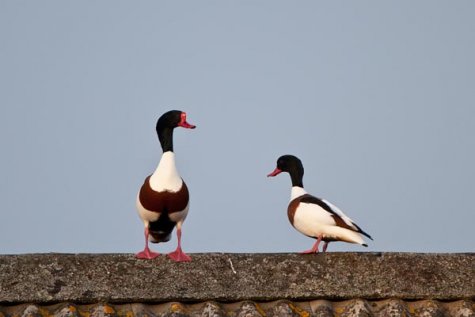Sheldrakes on roof
Photo: Arne Ader
Translation: Liis
Sheldrakes
| Sheldrake | Ristpart |
An arresting and not altogether uncommon view. Body language too – it is spring in the hearts of the pair. So sheldrakes look for nesting sites in their areas of the coast. Those moving in flocks are usually passing migrants.
We are used to see female ducks with prevalently brownish plumage – with a modest exterior, blending into nature. The sheldrakes are brightly coloured: bright red beak, head and upper part of neck dark green. Plumage is basically white, a broad rust-coloured band around the breast, rust colour also on part of the wing scapulars. Two lengthwise stripes on the back, one on the belly, the wing tips and tail are black. Certain wing feathers are dark green, with a metallic shimmer. Legs orange. The knob on the beak of the male makes him look more "manly“.
A large duck, almost as a small goose.
Breeds in small numbers, around a thousand pairs, but certainly eye-catching. The nest is built in places that are difficult to reach, such as abandoned fox dens, under buildings, in low attics. The female starts laying eggs in the beginning of April; there may be quite a lot (up to sixteen eggs is not particularly rare) and she lays alone on the eggs for a month.
Sheldrakes search for food splashing in shallow shore water or mud. Food is also searched in fields ploughed early, up to some kilometres inland from the coast.









